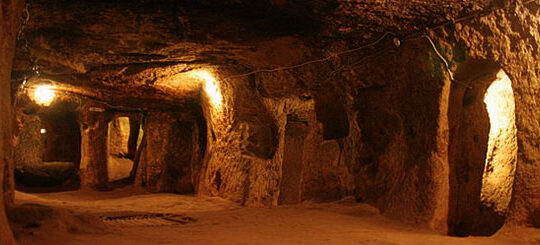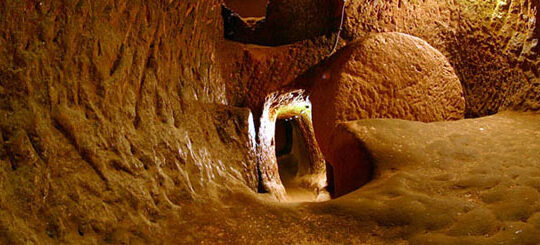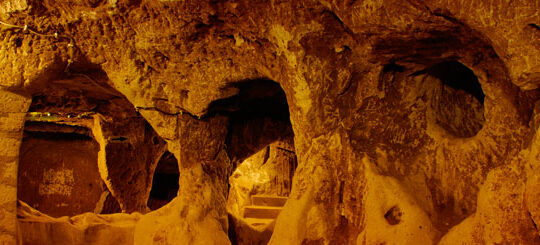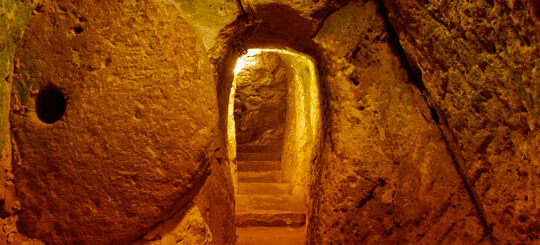There are several underground cities in Cappadocia carved into the soft tuff rocks. Two large ones near Nevsehir are open to the public. One is at Kaymakli, 21 kilometers to the south of Nevsehir and the other at Derinkuyu, 9 kilometers further to the south. The two underground cities were originally connected by a tunnel which is no longer negotiable.
Kaymakli and Derinkuyu underground cities were opened to the public in the years 1964 and 1965 respectively. Another underground city at Ozkonak, to the north of Avanos, is also open to the public. In Cappadocia, there are underground cities at Mucur, Orentepe, Gumuskent, Tatlarin, Ovaoren and Cok-tetoprak. The debris filling the tunnels and passages in these cities has not yet been cleared.
How Were the Underground Cities Built?
The same technique used in carving other structures in Cappadocia, was also employed in the underground cities. In other words, the tuff was first softened by wetting it with water and later carved. The carved surface would harden after drying.
The community must have been employed in construction. They worked in difficult positions inside tiny tunnels. An air shaft must have been first dug in order to provide clean air. The water from the well at the bottom of the airshaft could have been used to wet the tuff.
The debris removed by digging was probably dumped in nearby rivers. Otherwise, there would be large man-made mounds in existence.
How Big Were the Underground Cities?
In Kaymakli, one can reach the fourth floor, which is about 20 meters deep. In Derinkuyu, the 8th floor can be reached, situated at a depth of about 55 meters. There are 52 ventilation ducts in Derinkuyu, the depth of which vary between 70 and 85 meters. Villagers still draw water from the wells at the bottom of these ducts.
Derinkuyu underground city covers a total area of 1500 square meters. The capacity of just one cistern in the city is 30 tons. With the lower storey’s, which are now filled with debris, the city may have been about 12 storey’s deep, covering an area of 4 square kilometers and with a capacity to hold 20 thousand people. The capacity of Kaymakli was probably about half as much.
When was the Underground Cities Carved?
The exact date when the underground cities were carved is not known. Some finds dating from the Hittite period, which were unearthed at the Derinkuyu complex, indicate that the cities may have been in existence during the Hittite period. The Hittite findings include a flour-mill. The existence of chapels and Byzantine findings, on the other hand, indicate that the underground cities were used during the Christian period as well, perhaps by those fleeing the persecution of Arabs or iconoclasts.
Why Were the Underground Cities Made?
The visitor may have a cozy image of families living in these underground cities, in utmost security, with all their needs met and in possession of all the food and wine they needed. Healthy children, fed with nutritious sweet wine as they grew up, played with each other, rolling about tunnels, while parents could sip alcoholic wine in their chambers.
The so-called “underground cities” were probably used for protection by the people seeking sanctuary for brief periods only, during extreme emergencies. It is impossible to imagine that large numbers of people could live in these cities for long periods. Actually, these manmade caves were not cities at all but work places, where the grain and grapes produced on the fertile soil of the region were kept.
The dryness of the air inside underground cities explains why they were carved. The temperature inside these structures is constant throughout the year at about 15 degrees Centigrade. The dryness of the air and constant temperature make these caves ideal places for food storage.
The Hittites may have used the underground Cities to safeguard the agricultural wealth they derived from the Central Anatolian plateau. Other peoples may have used these caves for the same purpose.
The impressive security measures may have been taken’ not to protect the people, but the goods kept inside. Tunnels were made narrow, so that not the enemy seeking to massacre people, but needy thieves after grain and other kinds of food could enter and leave only one at a time if they could do so at all and take with them only small quantities. The chains on the walls of the lowest floor of Derinkuyu underground city and the affiliated lunatic asylum could have been used to restrain thieves. Alternatively, one can postulate that these devices were for those who went berserk working under difficult conditions, carrying sacks, rolling the mill, squeezing wine, in narrow spaces, without seeing sunlight.
Kaymakli Underground City While visiting the underground cities, one should follow the direction indicated by arrows. Better still one should be accompanied by a guide.
In the Kaymakli underground city, on the upper floor, there are stalls where animals were tied. After leaving this section, the signposts lead visitors through a chapel with graves on the right, food storage areas, and areas which are believed to be living quarters.
Derinkuyu Underground City The structures in the underground city in Derinkuyu are similar to those in Kaymakli. In addition, there is a missionary school. Also, in Derinkuyu, at the lowest level, there is a meeting chamber in the shape of a cross. On the same floor, there is a thick column. The holes carved on this column may indicate the places where chains used to bind prisoners were attached.
One of the strange features in Derinkuyu underground city is an affiliated lunatic asylum, perhaps the oldest in the world. Here, there were tanks for holy water, a dispensary, places where the mentally sick were tied and rooms where relatives could receive information on the condition of inmates.
Millstone Gates:
Different sections of the city were connected to each other by narrow tunnels through which only one man could proceed in a crawling position as a deterrent to possible enemy attack.
At the entrance of each section there was a gate in the shape of a millstone. When this stone was put into position, supported by stones from beneath, it could only be opened from the inside. Those inside could poke at the enemy with lances from inside, through a hole in the millstone.
Cappadocia Wine:
There are large basins which were used to squeeze grapes for wine. The juice flowed out into a pot through a hole in the corner of the basin. Not all the wine made in the underground cities was alcoholic. A sweet and thick variety mixed with ground local soil is very nutritious. Both varieties are made in Cappadocia today.
Air Shafts:
The city had eight floors and was about 40 meters deep. Only four floors have been cleared for public access. The air inside the city remains perfectly fresh no matter how many visitors there are, due to air shafts. One such shaft is seen on the left, while going through the tunnel leading to the Fourth floor. There is water at the bottom of the shaft and clean air enters through the opening at the top.
Kitchen:
The kitchen is on the second floor and visited on the way out. In order to avoid detection by the enemy, smoke from the kitchen was emitted via several little chimneys rather than a single large one. In the kitchen, there is one large granite millstone with holes carved in the surface. These holes were probably used as mortars to grind spices.
City Center:
In a little chamber on the right, after the kitchen and before the exit, a column like a tree trunk can be seen through a hole. This was the central axis around which the town as built.




